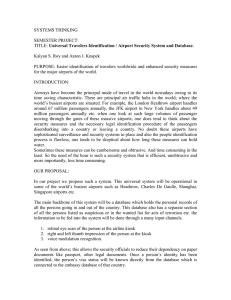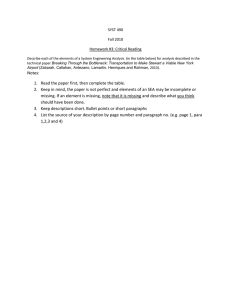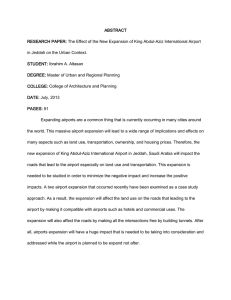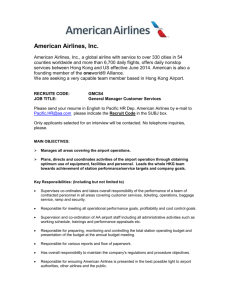The Impact of Blue Ocean Strategy in Low-cost Transport Hana Štverková
advertisement
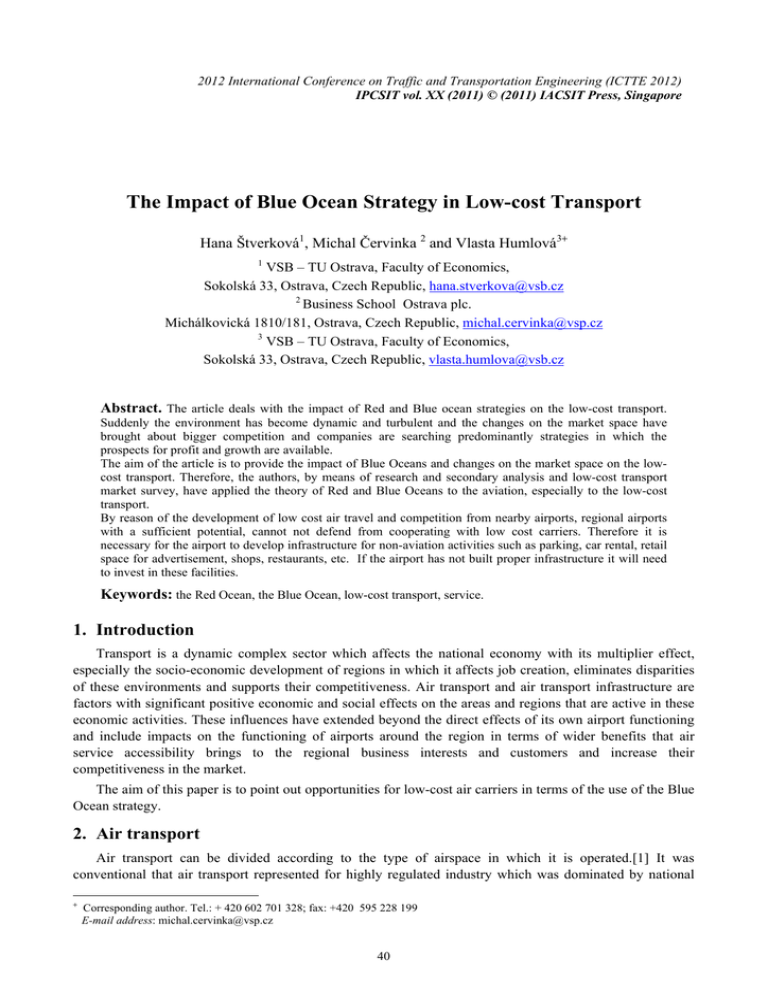
2012 International Conference on Traffic and Transportation Engineering (ICTTE 2012) IPCSIT vol. XX (2011) © (2011) IACSIT Press, Singapore The Impact of Blue Ocean Strategy in Low-cost Transport Hana Štverková1, Michal Červinka 2 and Vlasta Humlová3+ 1 VSB – TU Ostrava, Faculty of Economics, Sokolská 33, Ostrava, Czech Republic, hana.stverkova@vsb.cz 2 Business School Ostrava plc. Michálkovická 1810/181, Ostrava, Czech Republic, michal.cervinka@vsp.cz 3 VSB – TU Ostrava, Faculty of Economics, Sokolská 33, Ostrava, Czech Republic, vlasta.humlova@vsb.cz Abstract. The article deals with the impact of Red and Blue ocean strategies on the low-cost transport. Suddenly the environment has become dynamic and turbulent and the changes on the market space have brought about bigger competition and companies are searching predominantly strategies in which the prospects for profit and growth are available. The aim of the article is to provide the impact of Blue Oceans and changes on the market space on the lowcost transport. Therefore, the authors, by means of research and secondary analysis and low-cost transport market survey, have applied the theory of Red and Blue Oceans to the aviation, especially to the low-cost transport. By reason of the development of low cost air travel and competition from nearby airports, regional airports with a sufficient potential, cannot not defend from cooperating with low cost carriers. Therefore it is necessary for the airport to develop infrastructure for non-aviation activities such as parking, car rental, retail space for advertisement, shops, restaurants, etc. If the airport has not built proper infrastructure it will need to invest in these facilities. Keywords: the Red Ocean, the Blue Ocean, low-cost transport, service. 1. Introduction Transport is a dynamic complex sector which affects the national economy with its multiplier effect, especially the socio-economic development of regions in which it affects job creation, eliminates disparities of these environments and supports their competitiveness. Air transport and air transport infrastructure are factors with significant positive economic and social effects on the areas and regions that are active in these economic activities. These influences have extended beyond the direct effects of its own airport functioning and include impacts on the functioning of airports around the region in terms of wider benefits that air service accessibility brings to the regional business interests and customers and increase their competitiveness in the market. The aim of this paper is to point out opportunities for low-cost air carriers in terms of the use of the Blue Ocean strategy. 2. Air transport Air transport can be divided according to the type of airspace in which it is operated.[1] It was conventional that air transport represented for highly regulated industry which was dominated by national + Corresponding author. Tel.: + 420 602 701 328; fax: +420 595 228 199 E-mail address: michal.cervinka@vsp.cz 40 flag shipping companies and the state-owned airport. A single market substantially has removed all restrictions on commercial airlines flying within the EU (restrictions on the choice of routes, the number of flights, fares, etc.). At present, all EU airlines can provide air services on any route within the EU. Low cost airlines operate regular departing flights throughout the whole aircraft season, which is not different from traditional airlines. According to the CAA, there is no precise definition, which would be the low-cost carrier definition; instead, there is a general understanding of the operations and services models they operate. “What makes low-cost carrier airline different from traditional airlines, is primarily a low-cost operating model and a low level of services that are included in the ticket price.” [10, p. 94] By this assistance the operating costs are reduced, which creates scope for reducing the company ticket prices. This is that what makes them different from other airlines. The authors have decided to connect low-cost air travel in relation to the strategies of Blue Oceans, because the industry has untapped potential and it is important to humanity from the viewpoint of both national economies and individuals. 2.1. Service Services are results generated through activities in a mutual contact between supplier and customer and supplier internal activities with the aim to satisfy customer needs. Services are provided and consumed simultaneously. The company market supply usually includes certain services. Services may constitute a substantial or a relatively small proportion of the total market supply of organization. From this perspective, we distinguish five categories of market supply: • Purely material goods. • Tangible product along with the service. • Hybrid. The menu consists of two equal parts of goods and services. • Service along with a small proportion of tangible product. • Net service. The character of service in the aviation field is varied, yet in this area, there are typical features such as the intangible nature of most services, transience, easy to reproduce and suggestibility with emotions and psyche of customers when purchasing services. [3] In this paper, the authors will address service linked with a small proportion of tangible product, focusing on low-cost air travel. 3. Red and Blue Ocean Strategy The business environment market space provides space for two types of strategies - strategies of Red and Blue Oceans. The Red Ocean strategy is characterized by the existence of industries that have strict limits, comprise clearly defined rules of competitive behavior and it is a well known market space, in which there is a number of businesses and the chances are for profit and business growth. In this environment, products and services are easily interchangeable and replaceable. The current situation in the sectors that are crowded by such products is characterized by excess of supply over demand. The opposite of such a competitive environment is a Blue Ocean strategy. The Blue Ocean strategy is based on the assumption of the existence of unused market spaces created within Red Oceans through the differentiation from others. The main factor affecting the formation of the Blue Ocean is jump value creating the innovation value increase for the customer on the one hand, and for business on the other hand. Blue Oceans releases new demand and excludes competitors from the game. Value innovation is not aimed at the battle of competitors, but excludes them from the game by providing a jump increase in value in opening new market space. The Blue Ocean strategy must be seen as a combination of low cost and differentiation strategies. Customer Value is determined by cost-benefit ratio, the source of value for the companies are cost of ownership; therefore the value of innovation is achieved through the approach systems for the reconciliation of these three factors. 41 Service providers often complain that it is difficult to differentiate their service from competitive services. The firm can differentiate the quality of services that will have more capable staff in the customer relation field than the competition, and should create a more attractive environment in the venue of providing services or establish a better process of providing services. Firms in services can differentiate their image through signs and symbols, but this distinction is simply to imitate and doesn´t increase the jump value for the enterprise. 3.1. The Blue Ocean Strategy in low-cost transport A new phenomenon that contributes to the global output growth in air travel, are low cost airlines. The low-cost air transport model, which originated in the U.S. in the 2nd half of the 1970s, had been implemented in European countries before the end of the millennium. The massive influx of these companies was registered in Europe after 2000. The situation in this area is undergoing several dynamic changes. Their influence on the development of the massive use of air transport and mobility of the population is irreplaceable. The low-cost model of the operation of air transport means a massive reduction of costs that the company achieves by using modern technologies, fleet unification, the reduction of free services such as charging for food on board of the aircraft and the other related services. An example of the use of Blue Ocean strategy can be the relationship between the low-cost carrier and the airports. They also often use their power and difficult situation of regional airports and have their costs at the expense of the airport transferred, or require further payments such as marketing support, which they provide by themselves. With the intention of understanding the Blue Ocean strategy in the field of air transport, the authors show the Ryanair as an example, which left the Red Ocean and takes the opportunity in the new business approach. This is called grasping the opportunities and applying the Blue Ocean strategy theory into practice. “Ryanair is the largest low-cost company in the world. It operates more than 1,400 daily and flies to 160 destinations in 27 countries. The company operates 250 Boeing 737-800 and it has ordered 64 aircraft with delivery during the next two years. Ryanair employs more than 8,000 people and expects to carry approximately 73.5 million passengers this fiscal year.” [12] Ryanair has got into the position of leader in its strategy "to establish itself as Europe's leading low-cost carrier ever enhancing and expanding its range of low cost services. Ryanair's objective is to offer low fares that generate increased passenger volumes, while maintaining focus on cost containment and operational efficiency. " Key elements of this strategy are: Customer Service, frequent connections from point to point, flying short routes, operating from secondary airports, low operating costs, reducing the cost by operating a single aircraft fleet of Boeing 737-800. It continues an increasing efficiency of staff. It also reduces the cost of customer service, reducing both free services as well as reducing the cost of providing services without agents or forceful action of the European leader in this area, and pressures on suppliers of services, not least to the airports, which are often held as hostage by this force. This philosophy and strategies of Ryanair have crashed earlier conventions and axioms that air travel is luxury goods at high prices. As a result of massive advertising and sales of the part of tickets at very low prices, it has succeeded along with its followers and competitors in attracting millions of customers to the air transport who would not have flown otherwise. This trend on the one hand, has generated a large volume of new passengers on the other hand, and led to the problems of the classic carriers who have found themselves under pressure from price wars. Their response to this situation is different. Classic airlines respond to low-cost competition in diverse ways. Some carriers reduce prices, however their revenue often does not cover costs and economic problems are growing. If such a carrier reduces the quality and range of services on board which is close to the low-cost, it often loses business clients, who generate a significant proportion of revenues of conventional airlines. Even though these companies increase the number of passengers, they are not able to increase profit because of low fares and they often lose regular customers. Another group of airlines reduces costs though, but it tries to maintain a higher level of service and so it can obtain business travelers from those companies that have reduced the 42 level of service on board. These airlines are trying to differentiate themselves from low-cost competitors. 3.2. Low-cost Carriers Passanger Profiel The increasing revenues from non-airline businesses can be expected with the rising standard of living. We can talk about the dramatic changes in the number and composition of passengers because of the development of low cost carriers. The rapid development of regional airports is noted for example in Poland (Krakow, Katowice, Gdańsk, Poznan and Wroclaw) where the major regional airports’ share of low cost carrier increased from 42% passengers in 2005 to 63% passengers during first half of 2006.[6] The rise of passenger is achieved by developing low cost carriers. However, the passengers are also changing, too. The profile of a low-cost passenger according Salzburg Airport goes as follows: • Age of 35- 40 years, • Higher education (university), • Travels with partners and friends, • Average stay of 5 days, • 3-4 star hotel accommodation, • Internet ticket booking, • Travels more often owning to the lower prices. In 2006 the total volume of passengers was 1 878 000 at Salzburg Airport. The number of charter passengers was 760 000, the number of low cost passengers was 690 000 and the number of regular flights passengers was 420 000. Revenue from aeronautical activities amounted to EUR 30 million and 23 million from non-aeronautical activities. [8] It is likely to expect that the profile of passengers will change with the growth of living standard in new EU members as well as the airport income from non-aviation activities. The benefits of low-cost carriers operation: • low cost carriers can help to increase the market share of the airport and generate growth of passenger number (1 flight operated daily by B-737-800 brings 100,000 passengers per year), • the development of direct point to point connection without necessary at large airports (hub), • smaller airports can use their unused capacity. Financial specifics of low-cost carriers operation: • income grows primarily from non-aviation activities, • turnover of non-aviation activities equalizes with the turnover of aviation activities. 4. Conclusion By reason of the development of low cost air travel and competition from nearby airports, regional airports with a sufficient potential, cannot not defend from cooperating with low cost carriers. The demand for low cost airlines outweighs the supply and it is unlikely that the airports would reach more favorable financial conditions for their airports than other airports (EUR 4-8 per departing passenger). Ryanair uses its market power and it even does not offer payment for services, but it requires payment for each passenger. Ryanair demands Shannon airport to pay EUR 4,7 for each passenger which it will bring to the airport and will not pay any airport taxes. [11] Therefore it is necessary for the airport to develop infrastructure for non-aviation activities such as parking, car rental, retail space for advertisement, shops, restaurants, etc. If the airport has not built proper infrastructure it will need to invest in these facilities. It requires a thorough financial plan with an emphasis of return on investment especially in the period when the airport handles less than 1 million passengers per year. So what does the strategy of Blue Ocean consist in for low cost carriers? They take advantage of the opportunities and open new ways by cooperating with small regional airports along with reducing their costs 43 and ticket prices for passengers with an average income, what is acceptable and such a passenger uses more frequently the air transport. This is achieved by using a market space that is offered by Blue Ocean as well as by the transfer of the part of costs to the airport. This innovative behavior of airline leads to creating value for themselves, but also for enhancing and creating value for the end user. 5. References [1] BADÁNIK, Benedikt; LENOIR, Nathalie; MALAVOLTI, Estelle; KAZDA, Antonín; TOMOVÁ, Anna. FAST: future airport strategies. Aerlines magazine, No. 48, October 2010, 5 s. ISSN 1569-7649. URL: < http://www.aerlines.nl/wp-content/uploads/2010/09/48_Laplace_FAST-Future_Airport_Strategies.pdf> [2] BERÁNEK, Jaromír. Provozujeme pohostinství & ubytování. 1. vyd. Praha : Grada Publishing, 2004. 180 s. ISBN 80-86724-02-6. [3] BLECHARZ, Pavel; ŠTVERKOVÁ, Hana. Product Quality and Customer Benefit. Communications in Computer and Information Science. Part 1. Berlin : SPRINGER-VERLAG BERLIN, 2011, Volume 208, p. 382 – 388. ISSN 1865-0929. [4] ČSN EN ISO 9004 : 2000. Systémy managementu jakosti – směrnice pro zlepšování výkonnosti. Praha : Český normalizační institut, 2002. 94 s. [5] KOTLER, Philip. Marketing, management: Analýza, plánování, využití, kontrola. 9. přeprac. vyd. Praha : Grada Publishing, 1998. 712 s. ISBN 80-7169-600-5. [6] KUŚ, Dariusz. U.S. and European Perspectives on Regional Airport Development. U.S.-Europe Airport Conference. Wroclaw October 14-16, 2007. [7] PETRŮ, Z. Základy ekonomiky cestovního ruchu. 1. vyd. Praha : IDEA SERVIS, konsorcium, 1999. ISBN 8085970-29-5. [8] SCHANO, Richard. U.S. and European Perspectives on Regional Airport Development. U.S.-Europe Airport Conference. Wroclaw October 14-16, 2007. [9] SVÍTEK, Miroslav. Návrh informačního portálu pro multimodální dopravu. Projekt výzkumu a vývoje č. CG732106-120.[online].2011[cit. 28. 11. 2011]. Dostupná na WWW: <http://www.babtie.cz/download/cs_study_28_3/!!!_MMPortal_Rocni_zprava_2007_!!!.pdf> [10] ZWAN, J van der. Low-Cost Carriers - Europe, Een onderzoek naar de Europese low-cost carriers en hun netwerkontwikkeling. Universiteit Utrecht, 2006. [online] Dostupné na WWW: <http://cv.jvdz.net/LowCostCarriersEuropa.doc >. Anglická verze [online]. Dostupná na WWW: <http://www.jvdz.net/index2.html> [11] Airport Business, 2011. [online], [cit. 11. 11. 2011]. Dostupná na WWW: <http://www.airportbusiness.com/2011/04/shannon-airport-rejects-unreasonable-ryanair-demands/> [12] www.ryanair. com 44
